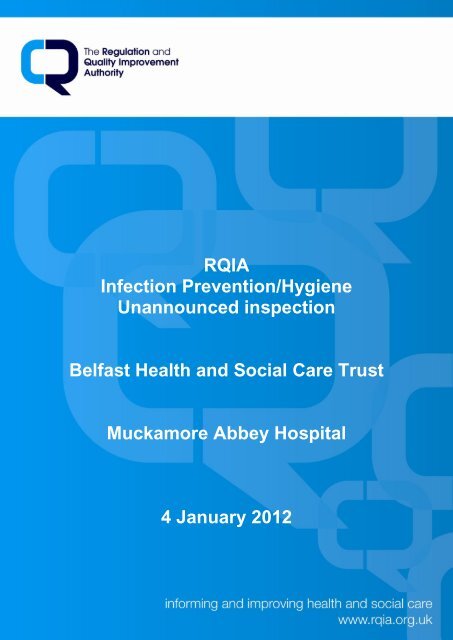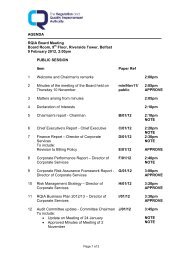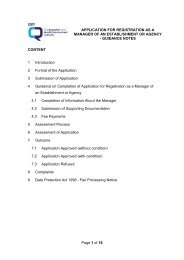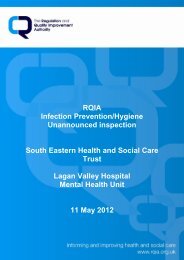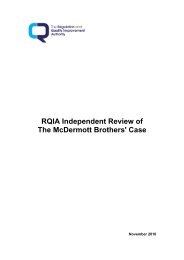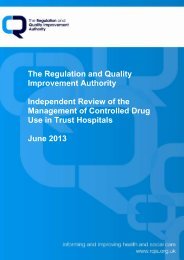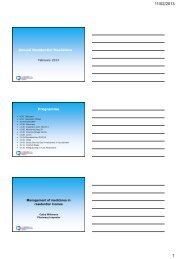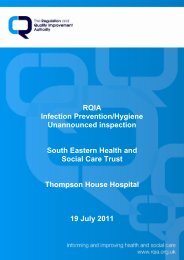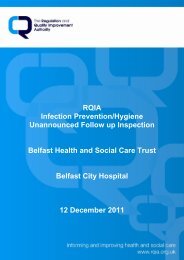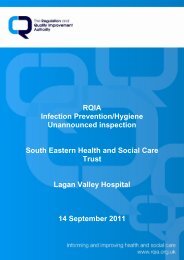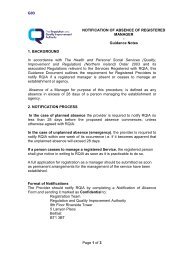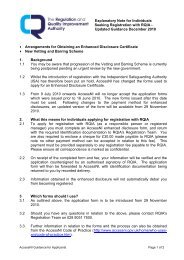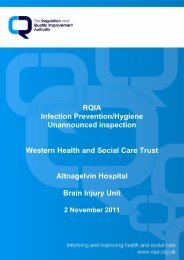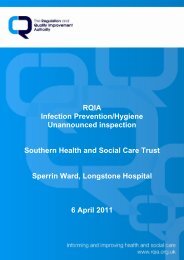Muckamore Abbey Hospital, Antrim - Regulation and Quality ...
Muckamore Abbey Hospital, Antrim - Regulation and Quality ...
Muckamore Abbey Hospital, Antrim - Regulation and Quality ...
You also want an ePaper? Increase the reach of your titles
YUMPU automatically turns print PDFs into web optimized ePapers that Google loves.
RQIA<br />
Infection Prevention/Hygiene<br />
Unannounced inspection<br />
Belfast Health <strong>and</strong> Social Care Trust<br />
<strong>Muckamore</strong> <strong>Abbey</strong> <strong>Hospital</strong><br />
4 January 2012
Contents<br />
1.0 Inspection Summary 1<br />
2.0 Background Information to the Inspection Process 5<br />
3.0 Inspections 6<br />
4.0 Unannounced Inspection Process 7<br />
4.1 Onsite Inspection 7<br />
4.2 Feedback <strong>and</strong> Report of the Findings 7<br />
5.0 Audit Tool 8<br />
6.0 Environment 10<br />
6.1 Cleaning 10<br />
6.2 Clutter 12<br />
6.3 Maintenance <strong>and</strong> Repair 13<br />
6.4 Fixture <strong>and</strong> Fittings 13<br />
6.5 Information 14<br />
7.0 Patient Linen 15<br />
7.1 Management of Linen 15<br />
8.0 Waste <strong>and</strong> Sharps 16<br />
8.1 Waste 16<br />
8.2 Sharps 16<br />
9.0 Patient Equipment 18<br />
10.0 Hygiene Factors 19<br />
11.0 Hygiene Practice 21<br />
12.0 Key Personnel <strong>and</strong> Information 23<br />
13.0 Summary of Recommendations 24<br />
14.0 Unannounced Inspection Flowchart 25<br />
15.0 RQIA Hygiene Team Escalation Policy Flowchart 26<br />
16.0 Action Plan 27
1.0 Inspection Summary<br />
An unannounced inspection was undertaken to <strong>Muckamore</strong> <strong>Abbey</strong><br />
<strong>Hospital</strong>, on the 5 January 2012. The hospital was assessed against<br />
the Regional Healthcare Hygiene <strong>and</strong> Cleanliness st<strong>and</strong>ards <strong>and</strong> the<br />
following areas were inspected:<br />
Finglass Ward<br />
Finglass is a 20 bed male ward situated on the <strong>Muckamore</strong> <strong>Abbey</strong><br />
<strong>Hospital</strong> site <strong>and</strong> is part of the Belfast Health <strong>and</strong> Social Care Trust.<br />
The ward provides single storey accommodation to adult patients with<br />
a learning disability, some of whom also present with challenging<br />
behaviours.<br />
The ward is situated in one of the old ‘villas’ which had been closed in<br />
the past but reopened to accommodate patients from other wards that<br />
have since closed.<br />
Patients range in age from their 30’s to late 60’s <strong>and</strong> most patients<br />
have been receiving in patient care on the hospital site for several<br />
years, some for decades.<br />
The inspectors were advised by the hospital management team that<br />
the ward is scheduled for closure within the next six months.<br />
Inspection Outcomes<br />
The results of the inspection showed compliance in all but one of the<br />
st<strong>and</strong>ards. Greater attention is required in relation to cleaning,<br />
particularly in sanitary areas <strong>and</strong> the dusting of surfaces. Issues<br />
highlighted in the minimally compliant waste section could be<br />
addressed quickly to achieve a compliant score. The introduction <strong>and</strong><br />
monitoring of a nurse cleaning schedule should also improve the<br />
patient equipment cleaning st<strong>and</strong>ard.<br />
The maintenance <strong>and</strong> repair of the ward should still be maintained until<br />
the ward is closed.<br />
The inspection team noted that several of the recommendations<br />
highlighted during an RQIA Mental Health <strong>and</strong> Learning Disability<br />
Team inspection carried out in September 2011 were still outst<strong>and</strong>ing.<br />
The trust should take action to address these issues as a matter of<br />
urgency.<br />
The inspection resulted in 15 recommendations for <strong>Muckamore</strong> <strong>Abbey</strong><br />
<strong>Hospital</strong>, a full list of recommendations is listed in Section 13.<br />
A detailed list of preliminary findings is forwarded to Belfast Health <strong>and</strong><br />
Social Care Trust within 14 days of the inspection to enable early<br />
1
action on identified areas which have achieved non complaint scores.<br />
The draft report which includes the high level recommendations in a<br />
<strong>Quality</strong> Improvement Plan is forwarded within 28 days of the inspection<br />
for agreement <strong>and</strong> factual accuracy. The draft report is agreed <strong>and</strong> a<br />
completed action plan is returned to RQIA within 14 days from the date<br />
of issue. The detailed list of preliminary findings is available from RQIA<br />
on request.<br />
The final report <strong>and</strong> <strong>Quality</strong> Improvement Plan will be available on the<br />
RQIA website. Reports <strong>and</strong> action plans will be subject to performance<br />
management by the Health <strong>and</strong> Social Care Board <strong>and</strong> the Public<br />
Health Agency.<br />
Notable Practice<br />
The inspection identified the following areas of notable practice:<br />
There was good documentation <strong>and</strong> information available for<br />
support services staff on cleaning practices<br />
The ward manager was in the process of reviewing <strong>and</strong><br />
indexing policies <strong>and</strong> guidelines for easier staff reference<br />
The RQIA inspection team would like to thank the staff at <strong>Muckamore</strong><br />
<strong>Abbey</strong> <strong>Hospital</strong> for their assistance during the inspection.<br />
The following tables give an overview of compliance scores noted in<br />
areas inspected by RQIA:<br />
Table 1 summarises the overall compliance levels achieved.<br />
Tables 2-7 summarise the individual tables for sections two to seven of<br />
the audit tool as this assists organisation to target areas that require<br />
more specific attention.<br />
Table 1<br />
Areas Inspected<br />
General Environment 79<br />
Patient Linen 89<br />
Waste 71<br />
Sharps 79<br />
Equipment 77<br />
Hygiene Factors 86<br />
Hygiene Practices 92<br />
Average Score 82<br />
Compliant:<br />
85% or above<br />
Partial Compliance: 76% to 84%<br />
Minimal Compliance: 75% or below<br />
2
Table 2<br />
General Environment<br />
Reception 84<br />
Corridors, stairs lift 82<br />
Public toilets<br />
N/A<br />
Ward/department -<br />
general (communal)<br />
68<br />
Patient bed area 79<br />
Bathroom/washroom 57<br />
Toilet 75<br />
Clinical room/treatment<br />
room<br />
80<br />
Clean utility room 90<br />
Dirty utility room<br />
N/A<br />
Domestic store 76<br />
Kitchen 94<br />
Equipment store<br />
N/A<br />
Isolation<br />
N/A<br />
General information 81<br />
Average Score 79<br />
Table 3<br />
Patient Linen<br />
Storage of clean linen 85<br />
Storage of used linen 92<br />
Laundry facilities<br />
N/A<br />
Average Score 89<br />
Table 4<br />
Waste <strong>and</strong> Sharps<br />
H<strong>and</strong>ling, segregation,<br />
storage, waste<br />
Availability, use, storage<br />
of sharps<br />
71<br />
79<br />
Compliant:<br />
85% or above<br />
Partial Compliance: 76% to 84%<br />
Minimal Compliance: 75% or below<br />
3
Table 5<br />
Patient Equipment<br />
Patient equipment 77<br />
Table 6<br />
Hygiene Factors<br />
Availability <strong>and</strong><br />
cleanliness of wash h<strong>and</strong> 77<br />
basin <strong>and</strong> consumables<br />
Availability of alcohol rub 83<br />
Availability of PPE 92<br />
Materials <strong>and</strong> equipment<br />
for cleaning<br />
93<br />
Average Score 86<br />
Table 7<br />
Hygiene Practices<br />
Effective h<strong>and</strong> hygiene<br />
procedures<br />
91<br />
Safe h<strong>and</strong>ling <strong>and</strong><br />
disposal of sharps<br />
100<br />
Effective use of PPE 100<br />
Correct use of isolation<br />
N/A<br />
Effective cleaning of ward 81<br />
Staff uniform <strong>and</strong> work<br />
wear<br />
88<br />
Average Score 92<br />
Compliant:<br />
85% or above<br />
Partial Compliance: 76% to 84%<br />
Minimal Compliance: 75% or below<br />
4
2.0 Background Information to the Inspection Process<br />
RQIA’s infection prevention <strong>and</strong> hygiene team was established to<br />
undertake a rolling programme of unannounced inspections of acute<br />
hospitals. The Department of Health Social Service <strong>and</strong> Public Safety<br />
(DHSSPS) commitment to a programme of hygiene inspections was<br />
reaffirmed through the launch in 2010 of the revised <strong>and</strong> updated<br />
version of 'Changing the Culture' the strategic regional action plan for<br />
the prevention <strong>and</strong> control of healthcare-associated infections (HCAIs)<br />
in Northern Irel<strong>and</strong>.<br />
The aims of the inspection process are:<br />
to provide public assurance <strong>and</strong> to promote public trust <strong>and</strong><br />
confidence<br />
to contribute to the prevention <strong>and</strong> control of HCAI<br />
to contribute to improvement in hygiene, cleanliness <strong>and</strong> infection<br />
prevention <strong>and</strong> control across health <strong>and</strong> social care in Northern<br />
Irel<strong>and</strong><br />
In keeping with the aims of the RQIA, the team will adopt an open <strong>and</strong><br />
transparent method for inspection, using st<strong>and</strong>ardised processes <strong>and</strong><br />
documentation.<br />
5
3.0 Inspections<br />
The DHSSPS has devised Regional Healthcare Hygiene <strong>and</strong><br />
Cleanliness st<strong>and</strong>ards. RQIA has revised its inspection processes to<br />
support the publication of the st<strong>and</strong>ards which were compiled by a<br />
regional steering group in consultation with service providers.<br />
RQIA's infection prevention/hygiene team have planned a three year<br />
programme which includes announced <strong>and</strong> unannounced inspections<br />
in acute <strong>and</strong> non-acute hospitals in Northern Irel<strong>and</strong>. This will assess<br />
compliance with the DHSSPS Regional Healthcare Hygiene <strong>and</strong><br />
Cleanliness st<strong>and</strong>ards.<br />
The inspections will be undertaken in accordance with the four core<br />
activities outlined in the RQIA Corporate Strategy, these include:<br />
Improving care: we encourage <strong>and</strong> promote improvements in the<br />
safety <strong>and</strong> quality of services through the regulation <strong>and</strong> review of<br />
health <strong>and</strong> social care<br />
Informing the population: we publicly report on the safety,<br />
quality <strong>and</strong> availability of health <strong>and</strong> social care<br />
Safeguarding rights: we act to protect the rights of all people<br />
using health <strong>and</strong> social care services<br />
Influencing policy: we influence policy <strong>and</strong> st<strong>and</strong>ards in health<br />
<strong>and</strong> social care<br />
6
4.0 Unannounced Inspection Process<br />
Trusts receive no advanced notice of the onsite inspection. An email<br />
<strong>and</strong> telephone call will be made by the Chief Executive of RQIA or<br />
nominated person 30 minutes prior to the team arriving on site. The<br />
inspection flow chart is attached in Section 14.<br />
4.1 Onsite Inspection<br />
The inspection team was made up of two inspectors, from RQIA’s<br />
infection prevention/hygiene team. One inspector led the team <strong>and</strong><br />
was responsible for guiding the team <strong>and</strong> ensuring they were in<br />
agreement about the findings reached. Membership of the inspection<br />
team is outlined in Section 12.<br />
The inspection of ward environments is carried out using the Regional<br />
Healthcare Hygiene <strong>and</strong> Cleanliness audit tool. The inspection<br />
process involves observation, discussion with staff, <strong>and</strong> review of some<br />
ward documentation.<br />
4.2 Feedback <strong>and</strong> Report of the Findings<br />
The process concludes with a feedback of key findings to trust<br />
representatives including examples of notable practice identified during<br />
the inspection. The details of trust representatives attending the<br />
feedback session is outlined in Section 12.<br />
The findings, report <strong>and</strong> follow up action will be in accordance with the<br />
Infection Prevention/Hygiene Inspection Process (methodology, follow<br />
up <strong>and</strong> reporting).<br />
The infection prevention/hygiene team escalation process will be<br />
followed if inspectors/reviewers identify any serious concerns during<br />
the inspection (Section 15).<br />
A number of documents have been developed to support <strong>and</strong> explain<br />
the inspection process. This information is currently available on<br />
request <strong>and</strong> will be available in due course on the RQIA website.<br />
7
5.0 Audit Tool<br />
The audit tool used for the inspection is based on the Regional<br />
Healthcare Hygiene <strong>and</strong> Cleanliness st<strong>and</strong>ards. The st<strong>and</strong>ards<br />
incorporate the critical areas which were identified through a review of<br />
existing st<strong>and</strong>ards, guidance <strong>and</strong> audit tools (Appendix 2 of Regional<br />
Healthcare Hygiene <strong>and</strong> Cleanliness st<strong>and</strong>ards). The audit tool follows<br />
the format of the Regional Healthcare Hygiene <strong>and</strong> Cleanliness<br />
St<strong>and</strong>ards <strong>and</strong> comprises of the following sections.<br />
1. Organisational Systems <strong>and</strong> Governance: policies <strong>and</strong><br />
procedures in relation to key hygiene <strong>and</strong> cleanliness issues;<br />
communication of policies <strong>and</strong> procedures; roles <strong>and</strong><br />
responsibilities for hygiene <strong>and</strong> cleanliness issues; internal<br />
monitoring arrangements; arrangements to address issues<br />
identified during internal monitoring; communication of internal<br />
monitoring results to staff<br />
This st<strong>and</strong>ard is not audited when carrying out unannounced<br />
inspections however the findings of the organisational<br />
system <strong>and</strong> governance at annual announced inspection will<br />
be, where applicable, confirmed at ward level.<br />
2. General Environment: cleanliness <strong>and</strong> state of repair of public<br />
areas; cleanliness <strong>and</strong> state of repair of ward/department<br />
infrastructure; cleanliness <strong>and</strong> state of repair of patient bed area;<br />
cleanliness <strong>and</strong> state of repair of toilets, bathrooms <strong>and</strong><br />
washrooms; cleanliness <strong>and</strong> state of repair of ward/department<br />
facilities; availability <strong>and</strong> cleanliness of isolation facilities;<br />
provision of information for staff, patients <strong>and</strong> visitors<br />
3. Patient Linen: storage of clean linen; h<strong>and</strong>ling <strong>and</strong> storage of<br />
used linen; ward/department laundry facilities<br />
4. Waste <strong>and</strong> Sharps: waste h<strong>and</strong>ling; availability <strong>and</strong> storage of<br />
sharps containers<br />
5. Patient Equipment: cleanliness <strong>and</strong> state of repair of general<br />
patient equipment<br />
6. Hygiene Factors: h<strong>and</strong> wash facilities; alcohol h<strong>and</strong> rub;<br />
availability of personal protective equipment (PPE); availability of<br />
cleaning equipment <strong>and</strong> materials.<br />
7. Hygiene Practices: h<strong>and</strong> hygiene procedures; h<strong>and</strong>ling <strong>and</strong><br />
disposal of sharps; use of PPE; use of isolation facilities <strong>and</strong><br />
implementation of infection control procedures; cleaning of<br />
ward/department; staff uniform <strong>and</strong> work wear<br />
8
Level of Compliance<br />
Percentage scores can be allocated a level of compliance using the<br />
compliance categories below. The categories are allocated as follows:<br />
Compliant<br />
85% or above<br />
Partial compliance 76 to 84%<br />
Minimal compliance 75% or below<br />
Each section within the audit tool will receive an individual <strong>and</strong> an<br />
overall score, to identify areas of partial or minimal compliance to<br />
ensure that the appropriate action is taken.<br />
9
6.0 Environment<br />
STANDARD 2.0<br />
GENERAL ENVIRONMENT<br />
Cleanliness <strong>and</strong> state of repair of public areas; cleanliness <strong>and</strong><br />
state of repair of ward/department infrastructure; cleanliness <strong>and</strong><br />
state of repair of patient bed area; cleanliness <strong>and</strong> state of repair<br />
of toilets, bathrooms <strong>and</strong> washrooms; cleanliness <strong>and</strong> state of<br />
repair of ward/department facilities; availability <strong>and</strong> cleanliness of<br />
isolation facilities; provision of information for staff, patients <strong>and</strong><br />
visitors.<br />
General Environment<br />
Reception 84<br />
Corridors, stairs lift 82<br />
Public toilets<br />
N/A<br />
Ward/department -<br />
general (communal)<br />
68<br />
Patient bed area 79<br />
Bathroom/washroom 57<br />
Toilet 75<br />
Clinical room/treatment<br />
room<br />
80<br />
Clean utility room 90<br />
Dirty utility room<br />
N/A<br />
Domestic store 76<br />
Kitchen 94<br />
Equipment store<br />
N/A<br />
Isolation<br />
N/A<br />
General information 81<br />
Average Score 79<br />
The above table outlines the findings in relation to the general<br />
environment of the facility inspected. The findings indicate that the<br />
st<strong>and</strong>ard overall was partially compliant, however there are three<br />
sections which have been highlighted in red which are minimally<br />
compliant <strong>and</strong> require prompt attention.<br />
6.1 Cleaning<br />
During the inspection there was some evidence to indicate compliance<br />
with regional specifications for cleaning. However, inspectors<br />
observed, that while cleaning mechanisms were in place these were<br />
not always effectively implemented or adhered to by staff.<br />
Greater attention to detail is required when cleaning. Throughout the<br />
wards the inspectors noted dust <strong>and</strong> cobwebs on high surfaces, in<br />
10
particularly around windows frames. Many of the ceiling light fittings<br />
had debris present, some of the air vents were dusty, <strong>and</strong> windows<br />
were in general dirty.<br />
In both the dining room <strong>and</strong> bed dormitory the high <strong>and</strong> low surfaces<br />
were dusty <strong>and</strong> the external <strong>and</strong> internal windows were dirty. In the<br />
dining room inspectors noted tables which had been cleaned after<br />
breakfast were streaked <strong>and</strong> stained; the edges <strong>and</strong> underside had<br />
food residue present. The dining room chairs were also stained <strong>and</strong><br />
there was dirt in the crevices. In the dormitory the base of the beds<br />
<strong>and</strong> the portable privacy screen were dusty.<br />
The ward has a lobby area off which are the central toilets, bathroom<br />
<strong>and</strong> shower room. At the bottom of each of the two dormitories there<br />
are an additional two combined shower <strong>and</strong> toilet rooms. A single<br />
patient toilet is located off the reception area. In total there are eight<br />
toilets, five showers <strong>and</strong> a bathroom which is in line with HBN 11-0.<br />
The bathroom/washroom <strong>and</strong> toilets both received a minimally<br />
compliant score <strong>and</strong> similar cleaning issues were observed in all<br />
sanitary areas. The tiled walls were stained <strong>and</strong> the grout between the<br />
tiles was dirty. There was a lack of ventilation in the shower rooms<br />
therefore condensation <strong>and</strong> mould was noted on the walls <strong>and</strong> window<br />
frames. The underside of the shower chairs <strong>and</strong> the bath hoist were<br />
stained. In a shower room the inspectors observed a plastic basket on<br />
the work surface beside the sink, the basket contained numerous<br />
toiletries.<br />
Picture1: Communal toiletries<br />
Some of the toiletries had been labelled in pen with patient initials<br />
others had not, a single comb was observed on the h<strong>and</strong> washing sink.<br />
The storage of personal toiletries in one basket is not recommended as<br />
it could encourage communal use. This issue had been highlighted<br />
during a RQIA Mental Health <strong>and</strong> Learning Disability Team inspection<br />
carried out in September 2011.<br />
In the shower room off one of the dormitory’s the vinyl floor coving was<br />
dirty <strong>and</strong> the grill on the floor drain under the shower had a build up of<br />
debris present. The shower chair was stained <strong>and</strong> the underside of the<br />
11
frame was very badly rusted, the inspectors asked for the chair to be<br />
removed immediately.<br />
In the bathroom there were several denture containers which had<br />
paper identification labels insitu, paper labels are a barrier to an<br />
effective cleaning process. The crevices of a metal framed dining room<br />
chair <strong>and</strong> the top of a step stool were dirty. The chair is not suitable for<br />
use in a bathroom. A wet bath mat which was stained, <strong>and</strong> showing<br />
signs of wear was lying on the floor. A plastic water jug was observed<br />
on the bath <strong>and</strong> was used to hold a bath plug; the inside of the jug was<br />
dirty. A pair of patients slippers were sitting on top of a inco pad on a<br />
shelf.<br />
In the toilet inspected, there was debris in the light fitting <strong>and</strong> the air<br />
vent was dusty. The vinyl flooring was dirty <strong>and</strong> discoloured around<br />
<strong>and</strong> behind the toilet.<br />
The clinical room is small <strong>and</strong> does not have a dedicated work surface<br />
for clinical procedures. The room has been fitted with metal cupboards<br />
which are in good repair, however the internal surfaces of the lower<br />
shelves <strong>and</strong> drawers were dusty <strong>and</strong> the wooden wall mounted shelves<br />
were showing signs of wear. The crevices of a metal frame chair were<br />
dirty. Inspectors noted that the temperature of the drugs fridge was not<br />
recorded consistently. It is advised that temperature checks are carried<br />
out on a daily basis to ensure medication is kept at the correct<br />
temperature <strong>and</strong> to identify if a fridge has failed to reach the required<br />
temperature <strong>and</strong> a cold chain failure has occurred.<br />
The kitchen is a good size, <strong>and</strong> had previously been used as a food<br />
production kitchen. The cupboards <strong>and</strong> walls were finished in stainless<br />
steel. The cleaning issues identified were in relation to the inaccessible<br />
areas such as skirting under shelves were dusty, there was some<br />
debris on the floor under the kitchen units <strong>and</strong> there were finger marks<br />
on the internal windows.<br />
In the domestic store the sluice sink required cleaning <strong>and</strong> personal<br />
staff clothes were observed.<br />
6.2 Clutter<br />
Inspectors observed that the ward was generally clutter free with the<br />
exception of the clinical <strong>and</strong> clean utility room. The patients bed areas<br />
have been personalised <strong>and</strong> day spaces were comfortable <strong>and</strong> well<br />
furnished.<br />
There is sufficient storage for the needs of the ward. However, the<br />
clinical room is small <strong>and</strong> space limited, the storage of equipment in<br />
this room should be reviewed <strong>and</strong> unwanted items disposed of. The<br />
clean utility room is a good size <strong>and</strong> has been well furnished with<br />
cupboards. There was a large amount of stock stored in cupboards,<br />
12
drawers <strong>and</strong> free st<strong>and</strong>ing units, boxes of stock were stored on work<br />
surfaces <strong>and</strong> on the floor. The inspectors recommend that these areas<br />
are de-cluttered <strong>and</strong> the ordering of stock reviewed to avoid<br />
overstocking.<br />
6.3 Maintenance <strong>and</strong> Repair<br />
The building has had some refurbishment, sanitary areas were<br />
upgraded but the vinyl flooring was in need of repair as several weld<br />
joints were damaged or missing. When floors are damaged they are<br />
not impervious to water <strong>and</strong> can not be effectively cleaned. The<br />
painted wood finishes around the h<strong>and</strong> wash sinks <strong>and</strong> baths were<br />
flaking <strong>and</strong> worn, surfaces need to have a cleanable finish. Through<br />
out the ward there were holes in the walls where fitting had been<br />
removed <strong>and</strong> broken wall tiles in the domestic store had been repaired<br />
with cement but not sealed.<br />
In one of the shower rooms the shower fitting holder was missing <strong>and</strong><br />
the shower hose was hanging down. The inspectors were advised this<br />
was under review <strong>and</strong> being risk assessed. In the other showers the<br />
fittings had been recessed into the plaster work behind the tiles. This<br />
issue had also been raised at the RQIA Mental Health <strong>and</strong> Learning<br />
Disability Team inspection carried out in September 2011.<br />
Picture 2: Dirty floor drain<br />
Picture 3: Rusted underside of<br />
shower chair<br />
6.4 Fixtures <strong>and</strong> Fittings<br />
The ward had an eclectic mix of furniture, acquired following closures<br />
of other wards on site. While some was of a good quality other pieces<br />
require re-sealing <strong>and</strong> varnishing to provide a surface which can be<br />
effectively cleaned.<br />
Notice boards were finished in felt or cork, which can not be effectively<br />
cleaned.<br />
13
6.5 Information<br />
Cleaning schedules for nursing staff detailing all equipment <strong>and</strong> staff<br />
responsibilities were not available. Information leaflets for visitors on<br />
general infections <strong>and</strong> MRSA <strong>and</strong> Clostridium difficile were not<br />
available. A poster on the colour coding of cleaning equipment was<br />
displayed at the reception area of the ward, however some nursing<br />
staff were not able to describe the correct colour coding to the<br />
inspectors.<br />
Addition Issues<br />
The RQIA Mental Health <strong>and</strong> Learning Disability Team inspection<br />
carried out in September 2011 <strong>and</strong> highlighted the lack of privacy<br />
screens between beds <strong>and</strong> that the shower rooms did not have<br />
enhanced privacy measures. These recommendations have not been<br />
actioned.<br />
Recommendations<br />
1. The trust should ensure that the systems <strong>and</strong> processes in<br />
place for environmental cleaning, provide the necessary<br />
assurance that cleaning is carried out effectively <strong>and</strong> that all<br />
staff are aware of their responsibilities.<br />
2. The healthcare environment should be repaired <strong>and</strong><br />
maintained, damaged fixtures <strong>and</strong> fittings replaced to<br />
maintain public confidence <strong>and</strong> to help reduce the risk of the<br />
spread of infection.<br />
3. Detailed nursing cleaning schedules should be developed.<br />
4. The trust should ensure that all staff are aware of the<br />
importance of monitoring drug fridge temperature<br />
consistently.<br />
14
7.0 Patient Linen<br />
STANDARD 3.0<br />
PATIENT LINEN<br />
Storage of clean linen; h<strong>and</strong>ling <strong>and</strong> storage of used linen; ward/<br />
department laundry facilities.<br />
7.1 Management of Linen<br />
Both sections were compliant in the storage of clean <strong>and</strong> used linen.<br />
There were some areas identified for improvement such as the storage<br />
of clean linen on unsealed wooden shelves these require sealing to<br />
provide a cleanable surface.<br />
There was a mix of traditional flat white linen <strong>and</strong> new sleep knit<br />
bedding, some pieces of the flat linen inspected were frayed. The<br />
inspectors observed bundles of towels stored in sanitary areas. The<br />
towels were stored on open trolleys <strong>and</strong> therefore exposed to possible<br />
aerosol contamination.<br />
Boxes containing freshly laundered patients personal clothes were<br />
noted on the floor of the central sanitary lobby, the boxes were over<br />
flowing <strong>and</strong> as a result clothing was spilling directly on to the floor.<br />
Used linen skips were also stored in this area, the frame of the skips<br />
were dusty <strong>and</strong> required cleaning.<br />
Recommendations<br />
Patient Linen<br />
Storage of clean linen 85<br />
Storage of used linen 92<br />
Laundry facilities<br />
N/A<br />
Average Score 89<br />
5. The trust should ensure the correct storage of clean linen in<br />
designated area which is clean <strong>and</strong> fit for purpose.<br />
15
8.0 Waste <strong>and</strong> Sharps<br />
STANDARD 4.0<br />
WASTE AND SHARPS<br />
Waste: Effectiveness of arrangements for h<strong>and</strong>ling, segregation,<br />
storage <strong>and</strong> disposal of waste on ward/department<br />
Sharps: Availability, use <strong>and</strong> storage of sharps containers on<br />
ward/department<br />
Waste <strong>and</strong> Sharps<br />
H<strong>and</strong>ling, segregation,<br />
storage, waste<br />
Availability, use, storage<br />
of sharps<br />
71<br />
79<br />
8.1 Waste<br />
The st<strong>and</strong>ard on the h<strong>and</strong>ling, segregation, storage <strong>and</strong> disposal of<br />
waste received a minimally compliant score. Inspectors observed that<br />
household waste bins were not available in the bathroom, clean utility<br />
room or shower rooms. Two of the waste bins in the central sanitary<br />
area which leads to the bathroom showers <strong>and</strong> toilets did not have a<br />
bin liner bag, this was rectified during the morning. The front of these<br />
bins were stained. The lid <strong>and</strong> base of the waste bin in the shower<br />
room off the dormitory was rusty.<br />
In the treatment room, paper packaging had been disposed of<br />
incorrectly in sharps boxes.<br />
8.2 Sharps<br />
The st<strong>and</strong>ard on use <strong>and</strong> storage of sharps was partially compliant.<br />
None of the sharps boxes inspected had the temporary closure<br />
mechanism in place <strong>and</strong> a sharps box was not signed. There were<br />
sharps boxes in the bathroom <strong>and</strong> shower rooms these were used for<br />
the disposal of razor heads, the boxes were sitting on a shelf but were<br />
not secured. Inspectors were advised at the feed back session that<br />
patients do not enter these areas unaccompanied <strong>and</strong> a risk<br />
assessment had been completed at ward level.<br />
A sharps tray in the clinical room had adhesive tape attached, tape will<br />
act as a barrier to effective cleaning <strong>and</strong> should be removed.<br />
Recommendations<br />
6 Waste bins should be available, clean <strong>and</strong> in good repair.<br />
16
7 The trust should monitor the implementation of its policies<br />
<strong>and</strong> procedures in respect of the management of waste <strong>and</strong><br />
sharps to ensure that safe <strong>and</strong> appropriate practice is in<br />
place.<br />
17
9.0 Patient Equipment<br />
STANDARD 5.0<br />
PATIENT EQUIPMENT<br />
Cleanliness <strong>and</strong> state of repair of general patient equipment.<br />
Patient Equipment<br />
Patient equipment 77<br />
As the patients in this ward are generally mobile <strong>and</strong> physically well<br />
there is no requirement for a large supply of patient equipment. All<br />
patient equipment is held in a small clinical room. The ward has<br />
recently received a resuscitation bag <strong>and</strong> all the equipment in the bag<br />
was in date <strong>and</strong> within sterile packaging. However the old resuscitation<br />
tray was still present <strong>and</strong> contained Magills forceps <strong>and</strong> a laryngoscope<br />
blade which had been removed from the sterile packaging. An old<br />
ambu bag in an open plastic bag was grubby <strong>and</strong> stained.<br />
Picture 4: Old cluttered resuscitation tray<br />
The tray should be removed as it is no longer required <strong>and</strong> may be<br />
used by staff during an emergency situation.<br />
There were three suction machines, one was an old model which sits<br />
on the floor <strong>and</strong> requires the containers to be cleaned manually. Staff<br />
should review the need for three machines. The underside frame of<br />
the drugs <strong>and</strong> dressing trolley were dirty <strong>and</strong> the mask on the portable<br />
nebulizer was stained. The mask <strong>and</strong> tubing should be single use if<br />
used for more than one patient or cleaned <strong>and</strong> changed in accordance<br />
with manufactures guidelines.<br />
Recommendations<br />
8 The trust <strong>and</strong> individual staff have a collective responsibility<br />
to ensure that patient equipment is clean, in a good state of<br />
repair <strong>and</strong> changed in line with manufactures guidelines.<br />
18
10.0 Hygiene Factors<br />
STANDARD 6.0<br />
HYGIENE FACTORS<br />
H<strong>and</strong> wash facilities; alcohol h<strong>and</strong> rub; availability of PPE;<br />
availability of cleaning equipment <strong>and</strong> materials.<br />
Hygiene Factors<br />
Availability <strong>and</strong><br />
cleanliness of wash h<strong>and</strong><br />
77<br />
basin <strong>and</strong> consumables<br />
Availability of alcohol rub 83<br />
Availability of PPE 92<br />
Materials <strong>and</strong> equipment<br />
for cleaning<br />
93<br />
Average Score 86<br />
While the st<strong>and</strong>ard achieved overall compliance the two sections in<br />
relation to the availability <strong>and</strong> cleanliness of h<strong>and</strong> wash sinks <strong>and</strong><br />
consumables <strong>and</strong> the alcohol rub dispensers were partially compliant<br />
<strong>and</strong> the following areas require improvement.<br />
The h<strong>and</strong> washing sink in the clinical room <strong>and</strong> the clean utility room<br />
had a plug <strong>and</strong> overflow present, both sinks required cleaning <strong>and</strong><br />
there was a build up of limescale present on the taps. The sink in the<br />
clinical room was worn <strong>and</strong> had limescale present on the overflow.<br />
Overflows to sinks, basins, baths <strong>and</strong> bidets are not recommended, as<br />
they constitute a constant infection control risk, much more significant<br />
than the possible risk of damage due to water overflowing (HTM 64).<br />
In all wards there were h<strong>and</strong> wash sinks that were not plug free, as<br />
h<strong>and</strong>s should be washed under running water, a plug should not be<br />
available. Particular care is required to ensure that lime scale is<br />
removed from taps <strong>and</strong> fittings as recent evidence has shown that lime<br />
scale may harbour biofilms <strong>and</strong> the build up of limescale can interfere<br />
with good cleaning <strong>and</strong> disinfection by masking <strong>and</strong> protecting<br />
pathogens.<br />
In the clean utility room access to the h<strong>and</strong> wash sink was blocked by<br />
boxes of supplies <strong>and</strong> a nail brush was observed on the sink surround.<br />
Nail brushes should be single use <strong>and</strong> disposed of immediately after<br />
use. There was a paper towel dispenser but no soap dispenser<br />
available.<br />
19
Picture 5: Dirty underside of alcohol dispenser<br />
The underside of the alcohol<br />
dispenser in the central<br />
sanitary area leading to the<br />
toilets <strong>and</strong> showers was very<br />
dirty <strong>and</strong> encrusted, the<br />
dispenser nozzle in the<br />
bathroom was blocked, the<br />
underside of the dispenser at<br />
reception <strong>and</strong> outside the<br />
shower room off the right<br />
dormitory bed area was<br />
stained.<br />
The domestic trolley was old <strong>and</strong> worn <strong>and</strong> the red bucket on the trolley<br />
required cleaning. The inspectors observed a red mop bucket <strong>and</strong> mop<br />
in the clean utility room, both had been used <strong>and</strong> were dirty. The ward<br />
sister confirmed these were used by nursing staff, it is recommended<br />
that they are included in the daily routine for changing mop heads <strong>and</strong><br />
that the buckets are cleaned <strong>and</strong> dried after each use.<br />
Recommendations<br />
9 The trust should ensure that h<strong>and</strong> washing sinks <strong>and</strong><br />
consumables are available, clean <strong>and</strong> in a good state of<br />
repair.<br />
10 Equipment used for the general cleaning of a ward should be<br />
clean, <strong>and</strong> fit for purpose.<br />
20
11.0 Hygiene Practices<br />
STANDARD 7.0<br />
HYGIENE PRACTICES<br />
H<strong>and</strong> hygiene procedures; h<strong>and</strong>ling <strong>and</strong> disposal of sharps; use<br />
of PPE; use of isolation facilities <strong>and</strong> implementation of infection<br />
control procedures; cleaning of ward/department; staff uniform<br />
<strong>and</strong> work wear.<br />
Hygiene Practices<br />
Effective h<strong>and</strong> hygiene<br />
procedures<br />
91<br />
Safe h<strong>and</strong>ling <strong>and</strong><br />
disposal of sharps<br />
100<br />
Effective use of PPE 100<br />
Correct use of isolation<br />
N/A<br />
Effective cleaning of ward 81<br />
Staff uniform <strong>and</strong> work<br />
wear<br />
88<br />
Average Score 92<br />
Due to the nature of the ward the inspectors observed minimal hygiene<br />
practices. The inspectors used questions to test staff knowledge.<br />
Compliant scores were achieved in all but one section, the section on<br />
effective cleaning which was partially complaint.<br />
There was no evidence to indicate patient equipment was routinely<br />
cleaned between patient use, the ward sister stated there were no<br />
formal nursing cleaning schedules. Staff duty sheets were used to<br />
indicated staff responsibilities for cleaning ward areas however these<br />
did not detail all equipment used at ward level. Domestic cleaning<br />
schedules were in place, both nursing <strong>and</strong> domestic cleaning schedules<br />
need to be reviewed <strong>and</strong> monitored to ensure cleaning issues<br />
highlighted in the environment section are on a cleaning programme<br />
<strong>and</strong> cleaned appropriately.<br />
In relation to h<strong>and</strong> hygiene when questioned not all staff were aware of<br />
the seven step technique for h<strong>and</strong> washing; one staff member stated<br />
four steps. The ward does not carry out h<strong>and</strong> hygiene audits, but at the<br />
feedback session the member of staff from the Infection Prevention <strong>and</strong><br />
Control team advised that a suitable audit tool for areas, where there<br />
would be limited observation opportunities, was under development.<br />
When questioned nursing staff were not fully aware of the correct<br />
dilution rates for disinfectants in use or aware of the correct colour<br />
coding system in place for cleaning equipment.<br />
21
There was a staff locker room, but the ward does not have changing<br />
facilities for staff.<br />
Recommendations<br />
11 The trust should ensure that staff knowledge <strong>and</strong> practice is<br />
kept up to date in relation to the dilution rates for<br />
disinfectants in use.<br />
12 Detailed nursing schedules should be developed to ensure<br />
all equipment <strong>and</strong> staff responsibilities are defined.<br />
13 H<strong>and</strong> hygiene audits should be commenced <strong>and</strong> the<br />
information displayed.<br />
22
12.0 Key Personnel <strong>and</strong> Information<br />
Members of the RQIA inspection team<br />
Mrs S O'Connor - Inspector Infection Prevention/Hygiene Team<br />
Mrs M Keating - Inspector Infection Prevention/Hygiene Team<br />
Trust representatives attending the feedback session<br />
M Mannion - Co - Director Education Nursing<br />
E Rafferty - Service Manager <strong>Muckamore</strong> <strong>Abbey</strong> <strong>Hospital</strong><br />
E McLarnon - Senior Nurse Manager<br />
R Davey - Support services Manager<br />
D Hamill - Estates Service Manager<br />
M O’Boyle - Ward Sister<br />
R Gillan - Infection Prevention <strong>and</strong> Control<br />
R Wilson - Assistant Support Service Manager<br />
Supporting documentation<br />
A number of documents have been developed to support the inspection<br />
process, these are:<br />
Infection Prevention/Hygiene Inspection Process (methodology,<br />
follow up <strong>and</strong> reporting)<br />
Infection Prevention/Hygiene Team Inspection Protocol (this<br />
document contains details on how inspections are carried out <strong>and</strong><br />
the composition of the teams)<br />
Infection Prevention/Hygiene Team Escalation Policy<br />
RQIA Policy <strong>and</strong> Procedure for Use <strong>and</strong> Storage of Digital Images<br />
This information is currently available on request <strong>and</strong> will be available<br />
in due course on the RQIA website.<br />
23
13.0 Summary of Recommendations<br />
1. The trust should ensure that the systems <strong>and</strong> processes in<br />
place for environmental cleaning, provide the necessary<br />
assurance that cleaning is carried out effectively <strong>and</strong> that all<br />
staff are aware of their responsibilities.<br />
2. The healthcare environment should be repaired <strong>and</strong><br />
maintained, damaged fixtures <strong>and</strong> fittings replaced to<br />
maintain public confidence <strong>and</strong> to help reduce the risk of the<br />
spread of infection.<br />
3. Detailed nursing cleaning schedules should be developed.<br />
4. The trust should ensure that all staff are aware of the<br />
importance of monitoring drug fridge temperature<br />
consistently.<br />
5. The trust should ensure the correct storage of clean linen in<br />
designated area which is clean <strong>and</strong> fit for purpose.<br />
6. Waste bins should be available, clean <strong>and</strong> in good repair.<br />
7. The trust should monitor the implementation of its policies<br />
<strong>and</strong> procedures in respect of the management of waste <strong>and</strong><br />
sharps to ensure that safe <strong>and</strong> appropriate practice is in<br />
place.<br />
8. The trust <strong>and</strong> individual staff have a collective responsibility<br />
to ensure that patient equipment is clean, in a good state of<br />
repair <strong>and</strong> changed in line with manufactures guidelines.<br />
9. The trust should ensure that h<strong>and</strong> washing sinks <strong>and</strong><br />
consumables are available, clean <strong>and</strong> in a good state of<br />
repair.<br />
10. Equipment used for the general cleaning of a ward should be<br />
clean, <strong>and</strong> fit for purpose.<br />
11. The trust should ensure that staff knowledge <strong>and</strong> practice is<br />
kept up to date in relation to the dilution rates for<br />
disinfectants in use.<br />
12. Detailed nursing schedules should be developed to ensure<br />
all equipment <strong>and</strong> staff responsibilities are defined.<br />
13. H<strong>and</strong> hygiene audits should be commenced <strong>and</strong> the<br />
information displayed.<br />
24
Reporting & Re-Audit<br />
Episode of Inspection<br />
Plan Programme<br />
14.0 Unannounced Inspection Flowchart<br />
Environmental Scan:<br />
Stakeholders & External<br />
Information<br />
Plan<br />
Programme<br />
Consider:<br />
Areas of Non-Compliance<br />
Infection Rates<br />
Trust Information<br />
RQIA Hygiene Team<br />
Prioritise Themes & Areas for Core Inspections<br />
Prior to Inspection Year<br />
Balance Programme<br />
January/February<br />
Schedule Inspections<br />
Prior to Inspection<br />
Identify & Prepare Inspection Team<br />
Day of Inspection<br />
Inform Trust<br />
Day of Inspection<br />
Carry out Inspection<br />
A<br />
Is there immediate risk<br />
requiring formal escalation?<br />
NO<br />
YES<br />
Invoke<br />
RQIA<br />
IPHTeam<br />
Escalation<br />
Process<br />
Day of Inspection<br />
Feedback Session with Trust<br />
14 days after<br />
Inspection<br />
28 days after<br />
Inspection<br />
Preliminary Findings<br />
disseminated to Trust<br />
Draft Report<br />
disseminated to Trust<br />
NO<br />
Does assessment of<br />
the findings require<br />
escalation?<br />
YES<br />
Invoke<br />
RQIA<br />
IPHTeam<br />
Escalation<br />
Process<br />
A<br />
14 days later<br />
Signed Action Plan<br />
received from Trust<br />
Within 0-3 months<br />
Is a Follow-Up required?<br />
Based on Risk Assessment/key<br />
indicators or Unsatisfactory <strong>Quality</strong><br />
Improvement Plan (QIP)?<br />
YES<br />
Invoke<br />
Follow-Up<br />
Protocol<br />
Process enables<br />
only 1 Follow-Up<br />
NO<br />
Open Report published to Website<br />
YES<br />
Is Follow-Up<br />
satisfactory?<br />
NO<br />
DHSSPS/HSC<br />
Board/PHA<br />
PHA<br />
25
15.0 Escalation Process<br />
RQIA Hygiene Team: Escalation Process<br />
B<br />
RQIA IPH<br />
Team<br />
Escalation<br />
Process<br />
Concern / Allegation / Disclosure<br />
Inform Team Leader / Head of Programme<br />
MINOR/MODERATE<br />
Has the risk been<br />
assessed as Minor,<br />
Moderate or Major?<br />
MAJOR<br />
Inform key contact <strong>and</strong> keep a record<br />
Inform appropriate RQIA Director <strong>and</strong> Chief Executive<br />
Record in final report<br />
Inform Trust / Establishment / Agency<br />
<strong>and</strong> request action plan<br />
Notify Chairperson <strong>and</strong><br />
Board Members<br />
Inform other establishments as appropriate:<br />
E.g.: DHSSPS, RRT, HSC Board, PHA,<br />
HSENI<br />
Seek assurance on implementation of actions<br />
Take necessary action:<br />
E.g.: Follow-Up Inspection<br />
26
16.0 Action Plan<br />
Ref No. Recommendations Designated<br />
department<br />
1. The trust should ensure that the systems <strong>and</strong> processes<br />
in place for environmental cleaning provide the necessary<br />
assurance that cleaning is carried out effectively <strong>and</strong> that<br />
all staff are aware of their responsibilities.<br />
Nursing<br />
PCSS<br />
IPC<br />
Action required<br />
‘Roles <strong>and</strong> responsibilities of Staff in<br />
relation to Environmental Cleanliness <strong>and</strong><br />
Cleanliness of Equipment’ policy under<br />
review.<br />
The consultation process in relation to the<br />
cleaning manual has resulted in requests<br />
for significant changes to the content <strong>and</strong><br />
format. Work is ongoing to have a revised<br />
final consultation document by February<br />
2012.<br />
Date for<br />
completion/<br />
timescale<br />
Mar 2012<br />
Feb 2012<br />
2. The healthcare environment should be repaired <strong>and</strong><br />
maintained, damaged fixtures <strong>and</strong> fittings replaced to<br />
maintain public confidence <strong>and</strong> to help reduce the risk of<br />
the spread of infection.<br />
Estates<br />
IPC<br />
Other<br />
appropriate<br />
staff<br />
All of these aspects will be monitored<br />
through the programme of Environmental<br />
Cleanliness Audits based on the<br />
Cleanliness Matters Strategy <strong>and</strong> results<br />
fed back through Balanced Scorecards.<br />
This is ongoing as part of Estate daily<br />
maintenance <strong>and</strong> refurbishment<br />
programmes.<br />
Ongoing<br />
Ongoing<br />
3. Detailed nursing cleaning schedules should be<br />
developed.<br />
Nursing<br />
IPECC<br />
A sub-group of IPECC (Infection<br />
Prevention & Environment <strong>and</strong><br />
Cleanliness Committee) will be set up to<br />
review <strong>and</strong> st<strong>and</strong>ardise cleaning<br />
schedules, <strong>and</strong> will establish any<br />
outst<strong>and</strong>ing issues of audit<br />
st<strong>and</strong>ardisation process.<br />
Feb 2012<br />
Agree a st<strong>and</strong>ardised audit which will be<br />
used in all areas. This will include<br />
st<strong>and</strong>ardised responsibilities. To be kept<br />
under review.<br />
Commencing<br />
Feb 2012<br />
27
Ref No. Recommendations Designated<br />
department<br />
4. The trust should ensure that all staff are aware of the<br />
importance of monitoring drug fridge temperature<br />
consistently.<br />
5. The trust should ensure the correct storage of clean linen<br />
in designated area which is clean <strong>and</strong> fit for purpose.<br />
Nursing<br />
Nursing<br />
6. Waste bins should be available, clean <strong>and</strong> in good repair. PCSS<br />
Nursing<br />
Action required<br />
Systematic roll out of the agreed<br />
st<strong>and</strong>ardised audit using the Maximiser<br />
system.<br />
The Medicines Code outlines procedures<br />
for use of medicine fridges. A<br />
pharmaceutical refrigerator temperature<br />
log sheet is maintained for each individual<br />
fridge, with records being maintained <strong>and</strong><br />
monitored by Ward Managers.<br />
Guidance regarding storage of linen is in<br />
the Regional Infection Prevention Manual.<br />
Linen storage <strong>and</strong> segregation guidance<br />
has been circulated to all Directorates.<br />
This states that all linen must be stored off<br />
the floor in a clean dedicated area that<br />
allows for ease of access <strong>and</strong> rotation of<br />
stock <strong>and</strong> that Linen rooms must have<br />
shelving that are easy to clean, <strong>and</strong><br />
cleaning frequencies must be at least<br />
quarterly.<br />
This is monitored as part of the<br />
Environmental Cleanliness Audit<br />
Programme.<br />
Regional contract for bins at adjudication<br />
stage.<br />
Environmental cleanliness audit<br />
programmes, which include daily ward<br />
checks, department <strong>and</strong> managerial<br />
audits, <strong>and</strong> IPC audits monitor<br />
compliance.<br />
Date for<br />
completion/<br />
timescale<br />
Ongoing<br />
Complete<br />
Ongoing<br />
Where an issue has been highlighted,<br />
action will be taken in conjunction with the<br />
appropriate department to ensure<br />
28
Ref No. Recommendations Designated<br />
department<br />
rectification.<br />
Action required<br />
Date for<br />
completion/<br />
timescale<br />
7. The trust should monitor the implementation of its policies<br />
<strong>and</strong> procedures in respect of the management of waste<br />
<strong>and</strong> sharps to ensure that safe <strong>and</strong> appropriate practice is<br />
in place.<br />
8. The trust <strong>and</strong> individual staff have a collective<br />
responsibility to ensure that patient equipment is clean, in<br />
a good state of repair <strong>and</strong> changed in line with<br />
manufactures guidelines.<br />
PCSS<br />
Nursing<br />
Nursing<br />
PCSS<br />
The Trust will pilot <strong>and</strong> roll out across all<br />
facilities the use of an electronic tool to<br />
audit waste management compliance<br />
against policy, procedure <strong>and</strong> RQIA<br />
requirements. This process will<br />
supplement the existing audit tools used<br />
by PCSS, IPC <strong>and</strong> also existing external<br />
audits conducted by Daniels (sharps box<br />
suppliers).<br />
Daniels’ audit completed Oct 2011 <strong>and</strong><br />
results disseminated.<br />
The consultation process in relation to the<br />
cleaning manual has resulted in requests<br />
for significant changes to the content <strong>and</strong><br />
format. Work is ongoing to have a revised<br />
final consultation document by February<br />
2012.<br />
Pilot<br />
completed<br />
Roll-out<br />
programme<br />
across Trust to<br />
be completed<br />
by Apr 2012<br />
Complete<br />
Feb 2012<br />
9. The trust should ensure that h<strong>and</strong> washing sinks <strong>and</strong><br />
consumables are available, clean <strong>and</strong> in a good state of<br />
repair.<br />
PCSS<br />
The manual includes roles <strong>and</strong><br />
responsibilities of trust staff in relation to<br />
patient equipment. A template will be<br />
used to record all cleaning of equipment.<br />
This is monitored as part of the<br />
Environmental Cleanliness Audit<br />
Programme. Staff are reminded of the<br />
importance of replenishing dispensers.<br />
Ongoing<br />
Environmental cleanliness audit<br />
programmes, which include daily ward<br />
checks, department <strong>and</strong> managerial<br />
audits, <strong>and</strong> IPC audits monitor<br />
compliance.<br />
Where an issue has been highlighted,<br />
action will be taken in conjunction with the<br />
29
Ref No. Recommendations Designated<br />
department<br />
Action required<br />
appropriate department to ensure<br />
rectification.<br />
Date for<br />
completion/<br />
timescale<br />
10. Equipment used for the general cleaning of a ward should<br />
be clean, <strong>and</strong> fit for purpose.<br />
Nursing<br />
PCSS<br />
Regular training is provided to all<br />
appropriate staff.<br />
The consultation process in relation to the<br />
cleaning manual has resulted in requests<br />
for significant changes to the content <strong>and</strong><br />
format. Work is ongoing to have a revised<br />
final consultation document by February<br />
2012.<br />
Feb 2012<br />
Environmental cleanliness audit<br />
programmes, which include daily ward<br />
checks, department <strong>and</strong> managerial<br />
audits, <strong>and</strong> IPC audits monitor<br />
compliance.<br />
Where an issue has been highlighted,<br />
action will be taken in conjunction with the<br />
appropriate department to ensure<br />
rectification.<br />
11. The trust should ensure that staff knowledge <strong>and</strong> practice<br />
is kept up to date in relation to the dilution rates for<br />
disinfectants in use.<br />
12. Detailed nursing schedules should be developed to<br />
ensure all equipment <strong>and</strong> staff responsibilities are<br />
defined.<br />
Nursing<br />
Nursing<br />
IPECC<br />
Regular training is provided to all<br />
appropriate staff.<br />
All staff have been reminded <strong>and</strong> made<br />
aware of poster advice.<br />
M<strong>and</strong>atory IPC training is provided, poster<br />
advice issued to wards, staff questioned<br />
at audit.<br />
A sub-group of IPECC (Infection<br />
Prevention & Environment <strong>and</strong><br />
Cleanliness Committee) will be set up to<br />
review <strong>and</strong> st<strong>and</strong>ardise cleaning<br />
schedules, <strong>and</strong> will establish any<br />
outst<strong>and</strong>ing issues of audit<br />
st<strong>and</strong>ardisation process.<br />
Completed <strong>and</strong><br />
ongoing<br />
Feb 2012<br />
30
Ref No. Recommendations Designated<br />
department<br />
Action required<br />
Agree a st<strong>and</strong>ardised audit which will be<br />
used in all areas. This will include<br />
st<strong>and</strong>ardised responsibilities. To be kept<br />
under review.<br />
Date for<br />
completion/<br />
timescale<br />
Commencing<br />
Feb 2012<br />
13. H<strong>and</strong> hygiene audits should be commenced <strong>and</strong> the<br />
information displayed.<br />
Nursing<br />
IPECC<br />
Systematic roll out of the agreed<br />
st<strong>and</strong>ardised audit using the Maximiser<br />
system.<br />
Once the audit tool for non-acute wards<br />
<strong>and</strong> departments has been developed <strong>and</strong><br />
agreed, audits will be commenced <strong>and</strong><br />
information displayed as appropriate.<br />
Jun 2012<br />
31


